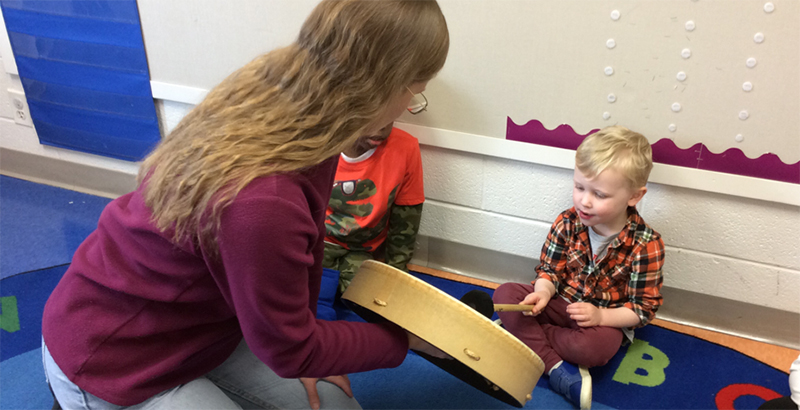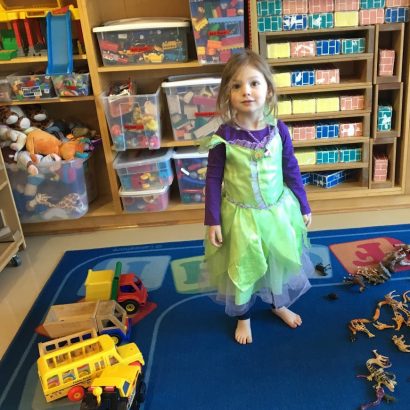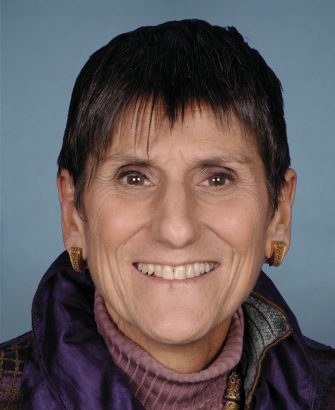As COVID-19 Threatens Millions of Child Care ‘Slots,’ Families Face Deep Disruptions to Their Children’s Early Learning and Social Development and to Their Own Jobs

Maggie Sorby hasn’t yet had the heart to tell her son Aleks that his beloved school has closed for good. Afterall, Aleks’s 3-K program took a shy toddler and helped him grow into a confident, outgoing preschooler.
Aleks attended a rare, reverse-inclusion pre-K class, which mixes typically developing children with disabled children, at the Elwyn Development Center in Media, Pennsylvania. When the program first closed in March for the pandemic, the family discussed how Aleks wouldn’t see his friends for a while. But when it closed permanently in May, Sorby and her husband, Vegard, decided not to break the news until they developed a clearer picture of what the future holds.
“It’s been a huge shock to us, and we are just trying to get our heads around what are the next steps because we don’t know what things will be available to us,” said Sorby, who works full time and had a second child in January. “We are going to get both of our kids’ names on waitlists all over, and if they get a slot, we’ll just have to do a pulse check and see if we’re comfortable with the place and what happens with the pandemic.”
“We’re not super hopeful for either age group that they are going to get anything anytime soon, particularly if centers are not able to operate at full capacity starting in the fall,” she said. “Aleks was on a waiting list for seven months before Elwyn.”
Families from coast to coast are facing the same dilemma.
Simon Workman, director of early childhood policy at the Center for American Progress, co-authored a study in April that predicted that without government help, the COVID-19 pandemic would put 4.5 million child care slots at risk of disappearing. In the state of New York, for example, that would mean the loss of 176,567 licensed child care slots, while in Texas it would mean a loss of 483,632 slots. Nationwide, it would be nearly half of available licensed child care slots.
Each of those “slots,” of course, represents a child who is missing out on early learning, a parent who may have difficulty keeping a job and an economy that could shrink.
“About 2 million parents each year face job disruption because of a problem with child care,” Workman said. “They have to quit a job or they face reduced hours or they can’t take a job because of a problem with child care. That was pre-pandemic. If we are now facing a reduced number of slots or reduced opening hours or providers who suddenly have to close because there’s a case of COVID-19 in their program, we’re going to see more and more disruptions to their jobs and it’s really going to matter if employers are flexible.”
The loss of revenue during months of lockdown, the increased costs of cleaning and cleaning supplies and the smaller class sizes that social distancing will require could push pre-K and day care programs beyond their limits.
“The finances for early childhood education are really tough,” Workman said. “It’s hard for providers to make a living. Even though parents are saying, ‘I’m paying so much for child care,’ it’s a really labor-intensive business. You don’t see supply increasing to respond to demand as you would in a more profitable industry. In higher-income communities, where providers can charge $20,000 a year, there is a supply of child care. In lower-income communities, there is not.”
At Elwyn, which delivers services in the Philadelphia area for medically fragile children and adults, Chief of Staff Rex Carney said the child care operation lost money every year. The organization had been trying to find another provider to take over its day care when the pandemic put a stop to all interest.
“We are not happy that COVID-19 has meant making decisions that affect families who seek quality child care programs,” Carney told The 74. “In lieu of additional funding for such programs, or some other mechanism to continue forward with this program, we must make decisions that will enable Elwyn to continue the broadest range of services for those who need our care.”
Whether small individually owned preschools or large multi-site day care centers, private providers often operate on a thin margin. Publicly funded pre-K programs could also suffer, as they did in the Great Recession when many states cut education budgets.
In New York City, budget cuts haven’t yet threatened the viability of the city’s universal pre-K program, though it has delayed the expansion of its 3-K program. Still, enrollment in the city’s pre-K program decreased by 3,000 this year, to about 62,000, which education officials attributed to parents worried about sending their children to school during the pandemic.
The decline, however, gave a record number of families — 77 percent — their first choice of schools for September, education officials said, while noting that the declining enrollment trend could reverse before the school year begins.
Jennifer Geller is on the city’s waiting list for a pre-K program she hopes her 4-year-old daughter, Sadie Mitchell, can attend this fall. Sadie has attended Chelsea Piers Kids, a day care on Manhattan’s West Side, since she was 5 months old, but she has been at home since the school closed for the pandemic in March. With no child care and both parents working at home full time — Geller is in marketing and her husband, Jonathan Mitchell, is a producer of the podcast The Truth — Sadie’s life has changed.

“She misses having teachers and kids and a full day of activities and learning,” Geller said. “She’s gone from that to too much time on the iPad. She sometimes talks in cartoon phrases now. She’ll say things like, ‘I’m sure it will all work out if we just work as a team.’”
Geller has stocked the house with arts and crafts, schedules early morning visits to the park so Sadie can play outside before too many other families come, and even set up a new “big girl” bed, but she fears her daughter is regressing.
“It’s super frustrating,” she said. “We’re reading child psychology books, trying to figure out what we can do.”
Of course, the books can’t address what to do if you live in a one-bedroom apartment in the densest, most coronavirus-impacted city in the nation. Geller is just holding on till either Chelsea Piers Kids can reopen or her first-choice public pre-K comes through.
In private pre-Ks coast to coast, maintaining enrollment is the difference between survival and going under.
Catherine Lieberman, co-owner and director of Bell’s School for People Under Six in Fletcher, North Carolina, has been in business 42 years. She’s kept her school open during the pandemic to serve the children of essential workers, but it hasn’t been easy.
“I’ve lost over half my business,” Lieberman said in “The Workforce Behind the Workforce,” a Center for American Progress virtual event. “I haven’t taken a paycheck since March 16 because I don’t think I can take one when I can’t afford to pay my staff. I’ve had to lay off 11 of my 13 employees in order to stay open. I’m struggling to pay the mortgage, the lights, to keep the water running and pay for the cleaning supplies I need just to stay open. It’s a financial impact, but it’s an emotional impact as well.”
With six sites in Chattanooga, Tennessee, the Chambliss Center for Children normally serves 750 children. In March, its enrollment dropped to 20, the children of essential workers, said Philip A. Acord, CEO of Chambliss, who also spoke at the May 28 virtual event.
Since May, the enrollment at Chambliss has increased to 75. The center has told parents they have until July 1 to decide whether they feel safe enough to allow their children to return. After that, Acord said, Chambliss would fill the slots from its 400-name waiting list.
“We got the payroll grant from the federal government,” Acord said. “Without that, I would probably be down on the street corner with my pan out asking for donations.”
Congress is considering a bailout of the child care industry. Democratic Congresswoman Rosa DeLauro of Connecticut has proposed the Child Care Is Essential Act. Unlike the $2 trillion CARES Act economic stimulus that was adopted in March and provided payroll protection and other grants for small businesses in general, including $13 billion for K-12 school districts nationwide, this bill would set aside $50 billion specifically for the child care industry.

“The workers and small business owners that care for our children while we work desperately need the federal government’s help,” DeLauro said in a statement. “The COVID-19 pandemic has our nation on the precipice of an economic catastrophe the likes of which we have never seen, and child care providers are facing financial ruin.”
Senators Joni Ernst, of Iowa, and Kelly Loeffler, of Georgia, both Republicans, have proposed that the next stimulus bill include $25 billion for child care.
No action has been taken on either proposal so far.
Steven Barnett, co-director and founder of the National Institute for Early Education Research at Rutgers University, said there are a lot of questions still to be answered about how the coronavirus outbreak has affected early childhood learning. He is in the midst of a study that asks 1,000 families with children 3 to 5 years old what happened with their child care during the pandemic. The results are expected by July.
“We have seen a lot of reporting, but most of it is anecdotal,” Barnett said. “What if we need to do this again, longer term? We need to know exactly who might need just how much catch-up. We need a more lasting picture of how home learning might have changed permanently for young children.”
Sorby, Aleks’s mother, knows how having a 4-year-old, a new baby and two working parents at home has changed her family’s life. She’s lucky, she says. Her husband, a video producer, and she, an operations manager for a company that provides teacher training, both have bosses who are understanding and allow them to work odd hours so they can tag-team child care. Sorby is more concerned about families who don’t have that flexibility.
“One of the things I’ve seen about this pandemic is that it is unmasking the things that have always been around us in society,” she said. “I think about our situation and how heartbreaking it is in terms of what the loss of the preschool means for our kid, but I also know that our kids are going to be OK and we are going to find a way to make it work.”
“I fear that the trend of this happening is going to really affect people’s livelihoods, and we are going to see a disproportionate impact on kids who were already vulnerable,” Sorby said. “Like everything else, the inequities that this pandemic are going to surface are going to hit particularly hard for the youngest learners.”
Get stories like these delivered straight to your inbox. Sign up for The 74 Newsletter

;)